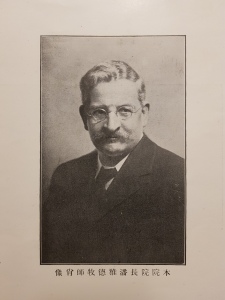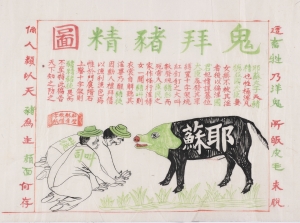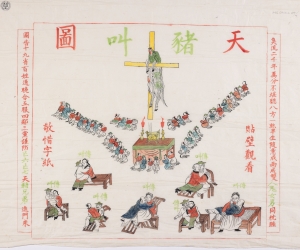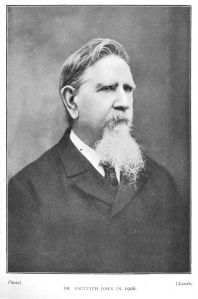In April 2015 the Bodleian received one of the most interesting donations of Chinese materials to have been made during my time as Curator of Chinese Collections. It was small in size, and fitted entirely into a single cardboard box. Of scrappy appearance, the materials were of the sort that many people would throw out following the death of their owner. This alone would ensure that they were rare once a few decades had elapsed.
The donor was the distinguished constitutional lawyer Anthony Bradley who was living in retirement near Oxford, and the materials were the nachlass of his maternal grandfather Arthur Bonsey (1858-1942), who was a younger contemporary of the well-known Welsh missionary Griffith John (1831-1912). Last year I was shocked to see an obituary of Professor Bradley in The Guardian, and greatly regret my failure to post an account of the donation before his death.
In 2018 Tony published a biography of Bonsey [1], whose work at the London Missionary Society’s station in Hankow extended over a period of some forty years, from his arrival there at the end of 1892 until his retirement in the spring of 1923. He spent the rest of his life in Oxford until his death on 2 December 1942, with so far as I know no contact with the Bodleian Library, much less any idea that his box of odds and ends would eventually become one of its treasures.
The following portrait of Bonsey is taken from a commemorative publication of the Griffith John College in Hankow, of which he was appointed Principal in 1913 [2]:
The College had been established in 1899 as the London Mission College 倫敦會書院, later changing its name to Boxue Shuyuan 博學書院 in Chinese and Griffith John College in English [3]. The main building with its bell tower survives as part of Wuhan No.4 Middle School 武汉市第四中学.
There are 197 printed items in Arthur Bonsey’s collection, of which 59 are single sheets. They are shelfmarked Sinica 6371-6421, 6423-6568 (Sinica 6422 is a manuscript) and they can all be found in Library catalogues except for two pieces of printed ephemera (Sinica 6552, 6553).
There are also 43 manuscripts, shelfmarked MS.Chin.a.24(1-13), MS.Chin.c.45, MS.Chin.d.77-78, MS.Chin.e.29, Sinica 6422. Some of them are single-sheet items, others are letters consisting of one or more sheets in an envelope grouped together under the same shelfmark. None of them can currently be found in Library catalogues, but they are all listed here with brief descriptions; all but three have been digitised.
Riots in the Yangtse valley
I distinctly remember the day when Tony delivered his grandfather’s nachlass to the New Library in Broad Street, Friday 27 March 2015. He opened the boot of his car to reveal a box of materials, on top of which lay a volume with a distinctive landscape orientation and grey paper covers. He was surpised when I recognised it immediately despite the fact that it was face down – Chinese books are much less varied in appearance than western ones, and I had long been familiar with two copies of the same work that were already in the Library’s collection: The cause of the riots in the Yangtse valley : a complete picture gallery (Hankow, 1891, 29 x 35cm), Sinica 5987 and (RHO) USPG 1861.
In view of the fact that the Bodleian already had two copies of this work, it was felt that a third was unnecessary, so it was kept by the family and I believe it was among the materials which Tony presented to Central China Normal University 华中师范大学 in Wuhan when he visited them a couple of months later in May 2015.
The work and its background are explained in full by Peter Perdue on the MIT Visualising cultures website, which uses the copy in Yale University Library. The copy in Princeton University Library has also been digitised.
In summary, it is a reproduction of an illustrated anti-Christian tract entitled Jinzun shengyu biye quantu 謹遵聖諭辟邪全圖, translated and introduced by Griffith John. The tract is said to have been written by Zhou Han 周漢 (1842-1922), a leading anti-Christian campaigner whose works were widely circulated in the middle and lower reaches of the Yangtse valley [4]. One does not need to be a Christian to find that the tract and its illustrations are utterly repellent – such material would be shocking no matter what religion it was directed against. For this reason I used to find it very hard to believe that Griffith John had actually reproduced it, despite his disclaimer in the preface (section 8) which states:
“This reproduction of the Picture Gallery being intended for the thoughtful few, and not at all for the multitude, no attempt has been made to gloss over its extreme grossness in picture and language. It is not the production of illiterate men. The Hunan antichristian publications, almost without exception, have scholars as their authors, and there can be no doubt about this one.”
However, among the Bonsey materials are seven manuscript illustrations which look as if they were indeed produced as drafts for the final block-cutting and printing. Bonsey must have seen the work being done and collected them as he approached the end of his first posting in Hankow (from 1882-1891).
Here is the draft of the first illustration, MS.Chin.a.24(7), described in the published text as “The Devils (foreigners) Worshipping the Hog (Jesus)”:
And here is what was actually printed and published (Princeton copy):
There are two drafts relating to the third illustration, MS.Chin.a.24(8, 9), described in the published text as “Propagating Religion in the Chapels”:
Perhaps the first of these two was intended to be for a block that was to print only the black portions of the illustration – in the taoban 套版 printing technique a separate block was required for each colour. In the event, the illustration that was finally printed and published had a different colour scheme and was much simpler:
The illustration shows the faithful worshipping the crucified Saviour, depicted as a hog, while foreign missionaries engage in acts of fornication at the back of the chapel.
Other works by Griffith John
Griffith John is a towering figure in the 19th-century Protestant mission, and much has been published about him both in print and on the internet; his Wikipedia entry is a good starting point.
Here I will only draw attention to the large number of his publications that were collected by Arthur Bonsey and which are now in the Bodleian Library. One of the many things that grated during my final years of service there was the increasing use of the term “world-class” by those who run the place to describe their own institution and its collections, something that struck me as being immodest to the point of vulgarity. So I leave it to others to examine my list of Griffith John’s publications, to search for them in WorldCat and elsewhere, and to decide for themselves whether such a claim can be made for this particular corpus.
The printed single-sheet items seem to be of exceptional rarity, which could be because they were considered too trivial and ephemeral to be taken into library collections; or they may indeed be in libraries but are lying unidentified and uncatalogued. I have found no examples of any of the six “sheet tracts” by Griffith John listed in Wylie’s Memorials of Protestant missionaries (Shanghae, 1867, 237-238) – but copies of all four of the multi-leaf tracts he lists are present in the Bodleian collection – nor have I found any other examples of the 35 single-sheet tracts in Bonsey’s collection. Of these, 28 are what I have described as “folded” single sheets, which look as if they might have been designed to be bound up into pamphlets; here is one of them, Sinica 6399 :
Griffith John regarded the establishment of schools, hospitals, and training colleges as an essential part of the Christian mission, and some of the single-sheet items bear witness to this, such as Sinica 6530, which explains the rationale behind it:
And on the subject of physical as well as spiritual welfare, John was particulary active in the anti-opium and anti-footbinding movements. I have compiled lists of materials on these subjects which are found in the Bodleian collections. Most of the anti-opium publications and all the anti-footbinding publications came from Bonsey; here is one of them, Sinica 6551:
Other single-sheet printed material
Visually impressive and certainly deserving attention are five calendars in the form of posters, clearly produced to promote the missionary enterprise. They are for the years 1887 (Sinica 6564), 1889 (Sinica 6565), 1890 (Sinica 6566), 1891 (Sinica 6562), and 1910 (Sinica 6567); this last one is printed in two colours and is particularly appealing:
Bonsey also collected a number of contemporary single-sheet items that were not related to the Protestant mission. For example official handouts of one sort or another that were read and then discarded, such as the handbill (or perhaps a small poster) announcing the establishment of mathematics and western science as subjects for the official government examinations, Sinica 6534:
The most spectacular among them is Sinica 6568, an enormous poster measuring 90 x 266cm. and printed on yellow paper with a red border of imperial dragons. The text is part of an imperial edict dated 1 February 1901 (according to the western calendar) requiring local officials to suppress all anti-foreign demonstrations and punish those responsible on pain of immediate dismissal and with no prospect of being re-hired. The injunction was presumably printed repeatedly in a number of locations – there is another example in the Bavarian State Library, printed from different blocks but of similar size and appearance. I suppose these huge posters were intended to be pasted to city walls and gates, or the walls of government offices, but this is only a guess. I’d be grateful to hear if anyone has more knowledge of this.
And finally, there is Sinica 6559, a delightful New Year print of the “Woosung Railway” 吳淞鐵路, China’s first passenger railway which opened in 1876 and ran from Shanghai to Wusong; its chequered history is the subject of a Wikipedia article. There are several iterations of this print, as an internet search will reveal.
Hymnal
Bonsey himself appears to have written and published very little indeed. In fact I have only been able to find a single copy (in SOAS Library) of a four-page pamphlet entitled The loving doctor Chow Chi Kwan (London Missionary Society, c.1900).
At the Griffith John College, as well as being Principal, Bonsey also taught history, English, and music, and there is a large musical score entitled The tune book of the C.C.R.T.S. Union hymn book (Hankow: Central China Religious Tract Society, 1905) in Rolvaag Memorial Library, St. Olaf College Northfield, MN (USA); again, this is the only copy I have found.
Although it was not published under his name, for many years Bonsey chaired the editorial team that compiled The R.T.S. hymnal with tunes, which was published by the Religious Tract Society of North & Central China in Shanghai in 1922. It has a preface signed G.A.C., who I presume is the Methodist missionary George Alfred Clayton.
There is a copy in the London Missionary Society Collection in the National Library of Australia, but apart from that the only other copy I know of is the presentation copy given to Bonsey in commemoration of his forty years’ service in Hankow, the front fly leaf of which bears a beautifully drawn dedicatory inscription. The volume is in the possession of the Bradley family, and Tony showed it to me in his son’s garden on 26 June 2020. That was the last time I saw him, and the pictures of it which he allowed me to take for my blog are an appropriate place to conclude this entry.
2. 級友錄, 漢口博學書院, 1919. Sinica 6508.
3. See 中國現代化的區域研究. 湖北省, 1860-1916 / 蘇雲峰著. – 台北 : 中央研究院近代史研究所, 民國70年[1981]. – (中央研究院近代史研究所專刊 ; 41). 145-146.
4. See 黄金乐: 周汉生卒年考, in 黑龙江史志, 346(2015:9), 18, 20; also 邵雍: 《谨遵圣谕辟邪全图》之解读, in 史學月刊, 223(2007:9), 131-134.




















Leave a comment